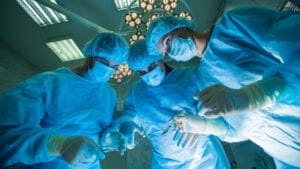Is it possible to be No. 2 and still end up the winner? Leaders of Abrazo Community Health Network see that as a distinct possibility.
“Clearly, Banner Health has the highest market share in Arizona,” says Michele Finney, market CEO for Abrazo, “so Abrazo wants to be No. 2.”
A year after Banner’s $1 billion-plus merger with the University of Arizona Health Network created Arizona’s largest health system, Abrazo has countered by investing more than $100 million in infrastructure and innovation and rebranded itself to create a growing reputation as an edgy alternative to Banner that offers one-stop shops for holistic healthcare and speciality healthcare.
“We will settle for No. 2 in market share,” says William Ellert, market chief medical officer for Abrazo, “but we strive to be No. 1 in quality and service.”
Finney says Tenet Healthcare acquired Abrazo in 2013 because the company’s analysis showed there was an opportunity to become one of the Top 2 players in the market.
“A lot of what you’re seeing with the repositioning of Abrazo and investments in the market is to sustain the trajectory that will allow Abrazo to be successful in accomplishing that objective,” Finney says.
Enter the future
To achieve its vision, innovation and investment have been priorities for Abrazo.
“When you have aspirations for a large market share, you have to stay current with technology and work with high-end physicians who can support innovative service lines,” Finney says.
In the last year, Abrazo has spent more than $100 million making that happen.
“We pretty much upgraded or replaced every financial and clinical system in our six hospitals,” Finney says. “Having an appropriate IT infrastructure allows you to move toward population health. More robustly, it allows you to integrate your system with other systems so you can have seamless transmission of data for improved patient care.”
Abrazo also made $50 million in capital investments for cutting-edge technology that allows it to offer innovative procedures and treatments that are unavailable elsewhere. Those innovative moves include:
• Abrazo is a partner in the new Cobalt Rehabilitation Hospital in Surprise, which is the first hospital in Arizona to provide a new robotic body-weight support system to allow paralyzed patients to walk.
• Abrazo’s Arrowhead Campus became the first and only hospital in Arizona to use the new Mazor Robotics Renaissance Guidance System for minimally invasive orthopedic spine surgery. Renaissance guides the surgeon’s tools and implants during both open and minimally invasive surgery, which may provide greater accuracy when compared with freehand conventional spine surgery.
• Abrazo became the first healthcare organization in Arizona to use NICO BrainPath, state-of-the art technology that offers patients a less-invasive surgical option and for previously inoperable brain conditions. This sophisticated tool enables neurosurgeons to navigate between the natural folds and neural structures in the brain without cutting or damaging anything else in its path. The result: An incision about the size of a dime, decreased surgical risks and faster recovery.
• Arrowhead is the first hospital in Arizona to use the MAKOplasty robotic surgical system for total hip replacement and the first in the West Valley to offer partial knee replacement robotic surgery. In addition, Arrowhead surgeons use the da Vinci surgical robotic system for a range of surgeries.
Focus on excellence
Abrazo Health rebranded itself as Abrazo Community Health Network in May 2014 to reflect its network of six acute-care hospitals, emergency centers, urgent care centers, primary practices and specialty practices.
“When we changed our name, we also changed the names of the hospitals to incorporate ‘campus’ into them,” says Kathleen Rondeau, Abrazo’s market chief business development officer. “Consumers know they have everything they need on a campus. Campus reflects a holistic way people can take care of themselves and their families. It’s a friendlier term, but it also reflects the transformative way we deliver healthcare.”
Ellert says Abrazo officials listened to members of the community, who told them they wanted family-centered hospitals where they could feel at home while getting healthcare.
“The other thing they want is access to specialty care and to high-end specialty care when they need it,” Ellert says. “That became a focus for us. We are primarily community-based hospitals, but in each of our facilities, we looked at one area in which we could excel.”
To provide that high-end care, Ellert says Abrazo Arizona Heart Hospital and Abrazo Arrowhead Campus have become leading providers of cardiac care, Abrazo Central Campus has emerged as a leader in neuroscience, Abrazo West Campus is home to a Level 1 Trauma Center, Arrowhead and Central have been recognized for excellence in stroke care and Abrazo Maryvale Campus is emerging as a leader in behavioral health.
Back to the future
Moving forward, Ellert says expanding primary care is going to be the key to Abrazo’s future.
“That is the gateway into healthcare,” Ellert says. “As we evolved, we talked a lot about the word ‘embrace’ and embracing the future of healthcare. Through healthcare reform, everyone has recognized the importance of having a solid primary care base.”
To facilitate that, Ellert says Abrazo will continue to partner with community physicians so consumers can still see their primary care doctor, but also have access to Abrazo’s network of hospitals, high-end specialists, urgent cares, ambulatory surgery sites and network health plan.
“A lot of our focus is on treating people as a whole person and educating them so they can proactively avoid adverse events,” Finney says, “but then managing those adverse events well when they do occur.”
Ellert expects Abrazo to continue to expand its ambulatory footprint with most healthcare being done outside of a hospital setting at urgent care centers and surgery centers, which can be more cost effective and often offers higher quality of care.
“As physicians, our focus used to be the patient in front of us,” Ellert says. “If you didn’t show up in my office, I didn’t feel all that responsible for you. We are moving away from that to say, ‘We are going to be responsible for a population.’ So whether on not you show up to my office, I am still going to assume responsibility for the health of my community. Therefore, being able to connect with our communities through our systems will be crucial to our success in the future.”
Also crucial will be the process of healthcare delivery.
“We need to learn new ways to communicate with each other and with our patients,” Ellert says.
“Being able to connect with your doctor through you smartphone or text is a much more convenient way to access healthcare than taking time out of your day, making an appointment, sitting in a doctor’s office, seeing the doctor and then leaving and forgetting half the things she or he told you. We want to embrace the future and create better, more efficient ways to serve an entire population. We are really focused on what we can do to make that happen.”




